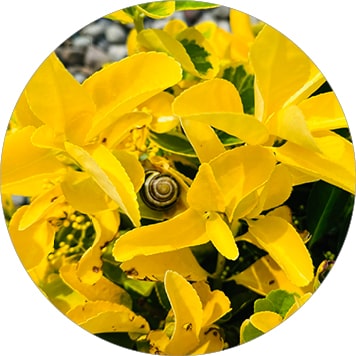The Life Cycle of a Snail Blog Post
STEAM Activities: Building Observational Skills
By Lisa L. Owens
Before sitting down to write each morning, I take a long walk, rain or shine. This ritual makes it easier to track steady seasonal changes like flowers blooming and leaves falling. And it’s fun to watch animals cycling through the seasons, too. I look for baby bunnies in late winter, fledgling crows in spring, and salmon spawning in fall. There’s always something new going on!
This photo shows a snail I spotted last summer, sealed into its shell and nestled among the cool leaves of an evergreen shrub. I checked on it often, and it remained safely in place for weeks, protected from predators and heat.
During your study of The Life Cycle of a Snail, try these activities to strengthen students’ powers of observation and ignite ongoing curiosity about the natural world around them.
Field Trip: Snail Safari

Plan a snail-finding excursion on school grounds or at another convenient location. You might find snails in plants or trees; under rocks or garden pots; on park benches or fences; or near water.
At the safari site, lead students on an investigative search. Emphasize the goal of observing snails in their natural habitat without disturbing them.
Discuss observations as you go. Note where snails are spotted (or not), what they look like, and what they’re doing. Take snail photos to display in your classroom and spark additional conversations about life cycles and the Snail Safari experience.
Writing Corner: Snail Mail
Briefly introduce the activity with, “Today you’ll each write a piece of snail mail to yourself! Who knows what the term snail mail means?” Invite guesses.
Explain that snail mail refers to mail delivered through the postal system instead of email. Point out that the “snail” part is a nod to physical mail moving more slowly than electronic email.

Have students draw a large snail shape on a sheet of 8.5" x 11" writing or construction paper. Then have them write a letter to themselves within the shape using the sample format as a guide.
Date: _
Dear Me,
I just read The Life Cycle of a Snail and learned that snails _.
The most interesting thing I observed during our Snail Safari is _.
One thing I’d still like to know about snails is_. If I learn more, I’ll tell you all about it!
Signed,
Me
Finally, have students fold their sheets inward in thirds to serve as self-containing envelopes. Ask them to address and “post” their snail mail to a designated collection spot.
In a week or two, hand deliver the letters to students and discuss what they’ve learned or observed about snails or the life cycle of living things since writing their letters.
About the Book
The Life Cycle of a Snail (The Child’s World, 2023) details the animal’s unique journey from egg to hatchling to the adult snail stage, during which the life cycle begins anew. Striking full-color photographs support the text, and carefully constructed front and back matter increase comprehension and encourage further inquiry.
Lisa L. Owens has written more than 100 books for young readers. Find her online: website, X (formerly known as Twitter), and Instagram.
